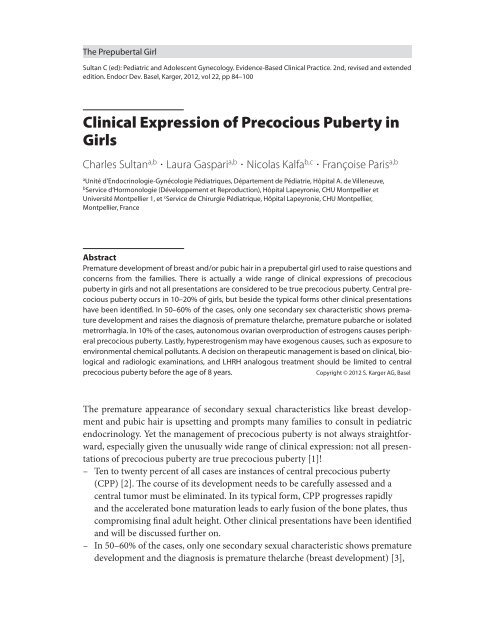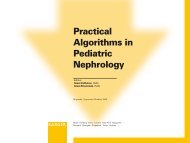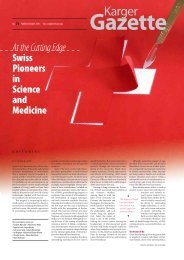Clinical Expression of Precocious Puberty in Girls - Karger
Clinical Expression of Precocious Puberty in Girls - Karger
Clinical Expression of Precocious Puberty in Girls - Karger
You also want an ePaper? Increase the reach of your titles
YUMPU automatically turns print PDFs into web optimized ePapers that Google loves.
The Prepubertal Girl<br />
Sultan C (ed): Pediatric and Adolescent Gynecology. Evidence- Based <strong>Cl<strong>in</strong>ical</strong> Practice. 2nd, revised and extended<br />
edition. Endocr Dev. Basel, <strong>Karger</strong>, 2012, vol 22, pp 84–100<br />
<strong>Cl<strong>in</strong>ical</strong> <strong>Expression</strong> <strong>of</strong> <strong>Precocious</strong> <strong>Puberty</strong> <strong>in</strong><br />
<strong>Girls</strong><br />
Charles Sultan a,b Laura Gaspari a,b Nicolas Kalfa b,c Françoise Paris a,b<br />
a<br />
Unité d’Endocr<strong>in</strong>ologie- Gynécologie Pédiatriques, Département de Pédiatrie, Hôpital A. de Villeneuve,<br />
b<br />
Service d’Hormonologie (Développement et Reproduction), Hôpital Lapeyronie, CHU Montpellier et<br />
Université Montpellier 1, et c Service de Chirurgie Pédiatrique, Hôpital Lapeyronie, CHU Montpellier,<br />
Montpellier, France<br />
Abstract<br />
Premature development <strong>of</strong> breast and/or pubic hair <strong>in</strong> a prepubertal girl used to raise questions and<br />
concerns from the families. There is actually a wide range <strong>of</strong> cl<strong>in</strong>ical expressions <strong>of</strong> precocious<br />
puberty <strong>in</strong> girls and not all presentations are considered to be true precocious puberty. Central precocious<br />
puberty occurs <strong>in</strong> 10–20% <strong>of</strong> girls, but beside the typical forms other cl<strong>in</strong>ical presentations<br />
have been identified. In 50–60% <strong>of</strong> the cases, only one secondary sex characteristic shows premature<br />
development and raises the diagnosis <strong>of</strong> premature thelarche, premature pubarche or isolated<br />
metrorrhagia. In 10% <strong>of</strong> the cases, autonomous ovarian overproduction <strong>of</strong> estrogens causes peripheral<br />
precocious puberty. Lastly, hyperestrogenism may have exogenous causes, such as exposure to<br />
environmental chemical pollutants. A decision on therapeutic management is based on cl<strong>in</strong>ical, biological<br />
and radiologic exam<strong>in</strong>ations, and LHRH analogous treatment should be limited to central<br />
precocious puberty before the age <strong>of</strong> 8 years.<br />
Copyright © 2012 S. <strong>Karger</strong> AG, Basel<br />
The premature appearance <strong>of</strong> secondary sexual characteristics like breast development<br />
and pubic hair is upsett<strong>in</strong>g and prompts many families to consult <strong>in</strong> pediatric<br />
endocr<strong>in</strong>ology. Yet the management <strong>of</strong> precocious puberty is not always straightforward,<br />
especially given the unusually wide range <strong>of</strong> cl<strong>in</strong>ical expression: not all presentations<br />
<strong>of</strong> precocious puberty are true precocious puberty [1]!<br />
– Ten to twenty percent <strong>of</strong> all cases are <strong>in</strong>stances <strong>of</strong> central precocious puberty<br />
(CPP) [2]. The course <strong>of</strong> its development needs to be carefully assessed and a<br />
central tumor must be elim<strong>in</strong>ated. In its typical form, CPP progresses rapidly<br />
and the accelerated bone maturation leads to early fusion <strong>of</strong> the bone plates, thus<br />
compromis<strong>in</strong>g f<strong>in</strong>al adult height. Other cl<strong>in</strong>ical presentations have been identified<br />
and will be discussed further on.<br />
– In 50– 60% <strong>of</strong> the cases, only one secondary sexual characteristic shows premature<br />
development and the diagnosis is premature thelarche (breast development) [3],
Table 1. Mean ages for normal pubertal development stages <strong>in</strong> girls, based on<br />
Tanner stages for breast development (B) and pubic hair (P)<br />
Pubertal stage<br />
Breast buds (B2<br />
Sparse pubic hair growth (P2)<br />
Darker, coarser pubic hair growth (P3)<br />
Growth spurt<br />
Menarche<br />
Adult pubic hair <strong>in</strong> type and quantity (P5)<br />
Mature breast (B5)<br />
Age, years<br />
10.1<br />
11.2<br />
12.2<br />
12.2<br />
12.7<br />
14<br />
14<br />
premature pubarche (appearance <strong>of</strong> pubic hair) [4] or metrorrhagia. In these<br />
cases, the etiology should be sought, and cl<strong>in</strong>ical, biological and radiographic<br />
management is devoted to prevent<strong>in</strong>g the precocious onset <strong>of</strong> puberty.<br />
– In 10% <strong>of</strong> the cases, the development <strong>of</strong> secondary sexual characteristics has an<br />
adrenal or ovarian cause, with an autonomous hyperproduction <strong>of</strong> estrogens<br />
caus<strong>in</strong>g precocious pseudopuberty <strong>in</strong>dependently <strong>of</strong> gonadotrop<strong>in</strong> activation.<br />
In these cases, it has become <strong>in</strong>creas<strong>in</strong>gly evident that the hyperestrogenism<br />
may have an exogenous cause, such as environmental chemical pollutants <strong>in</strong><br />
the air, water, and food cha<strong>in</strong>. These xenoestrogens have a chemical structure<br />
that mimics the actions <strong>of</strong> natural estrogens by stimulat<strong>in</strong>g the activity <strong>of</strong> target<br />
tissues.<br />
In all cases, the <strong>in</strong>itial step is to evaluate the level <strong>of</strong> estrogen secretion, <strong>in</strong> terms <strong>of</strong><br />
both its impact on target organs (breasts, growth rate, bone maturation, etc.) and its<br />
course over time. A good understand<strong>in</strong>g <strong>of</strong> the various ways that precocious puberty<br />
cl<strong>in</strong>ically presents <strong>in</strong> girls is vital for the decision on therapeutic management, as the<br />
optimal treatment is <strong>of</strong>ten not evident dur<strong>in</strong>g the <strong>in</strong>itial evaluation.<br />
Evaluation <strong>of</strong> the Pubertal Stage<br />
One <strong>of</strong> the first steps <strong>in</strong> diagnosis is the estimation <strong>of</strong> pubertal stage. The Tanner<br />
stages have been the reference for many years, as they are very well codified (table 1).<br />
In rout<strong>in</strong>e cl<strong>in</strong>ical practice, this relatively precise stag<strong>in</strong>g is complemented by exam<strong>in</strong>ation<br />
<strong>of</strong> the sesamoid bone <strong>of</strong> the hand. This marker <strong>of</strong> bone maturation appears<br />
toward 11 years and signals the start <strong>of</strong> puberty.<br />
The Tanner stages have been the reference for generations <strong>of</strong> pediatric endocr<strong>in</strong>ologists.<br />
In an American study <strong>of</strong> a very large cohort <strong>of</strong> girls exam<strong>in</strong>ed between the<br />
ages <strong>of</strong> 3 and 11 years [5], most <strong>of</strong> the girls appeared to enter puberty at a younger<br />
age (9.9 years for B2 and 10.5 years for P2). This drop <strong>in</strong> the age <strong>of</strong> puberty onset was<br />
<strong>Cl<strong>in</strong>ical</strong> <strong>Expression</strong> <strong>of</strong> <strong>Precocious</strong> <strong>Puberty</strong> 85
most evident <strong>in</strong> black girls. The authors attributed their f<strong>in</strong>d<strong>in</strong>gs to the impact <strong>of</strong><br />
environmental factors (chemical pollution). The f<strong>in</strong>d<strong>in</strong>gs that most <strong>of</strong> the girls enter<strong>in</strong>g<br />
puberty at the youngest ages (between 6 and 8 years) do not present with short<br />
adult height [6] and that the duration <strong>of</strong> puberty (tempo) is <strong>in</strong>versely l<strong>in</strong>ked to the<br />
age <strong>of</strong> onset (tim<strong>in</strong>g) should be considered as relevant to cl<strong>in</strong>ical practice, especially<br />
to any decision about therapeutic management. The prediction <strong>of</strong> adult height based<br />
on bone age, accord<strong>in</strong>g to the method <strong>of</strong> Bayley- P<strong>in</strong>eau [7], is one <strong>of</strong> the most reliable<br />
parameters <strong>in</strong> this regard [8].<br />
These works as a whole have done much to elucidate the development <strong>of</strong> secondary<br />
sexual characteristics and the normal course <strong>of</strong> puberty <strong>in</strong> girls [9, 10].<br />
The activation <strong>of</strong> the gonadotropic axis is marked by a peak <strong>in</strong> LH above 5 μIU/ml<br />
and an LH/FSH ratio above 1 dur<strong>in</strong>g LHRH test<strong>in</strong>g [11]. Conversely to the assertions<br />
<strong>of</strong> other groups, we do not accept the basal values <strong>of</strong> LH (whatever the standard used)<br />
as a marker <strong>of</strong> pubertal onset.<br />
The measurement <strong>of</strong> plasma estradiol by radioimmunology is not a reliable method<br />
to evaluate the onset <strong>of</strong> puberty because <strong>of</strong> its low specificity and high fluctuations.<br />
Only the analysis <strong>of</strong> the biological activity <strong>of</strong> estrogens us<strong>in</strong>g ultrasensitive methods is<br />
able to provide useful <strong>in</strong>formation on pubertal onset.<br />
Last, pelvic ultrasonography with measurement <strong>of</strong> the uterus should be systematically<br />
performed: onset <strong>of</strong> puberty shows an <strong>in</strong>crease <strong>in</strong> ovarian volume (>1.5<br />
cm 3 ) and uter<strong>in</strong>e size, with length exceed<strong>in</strong>g 3.5 cm. The f<strong>in</strong>d<strong>in</strong>g <strong>of</strong> an <strong>in</strong>creased<br />
diameter <strong>of</strong> the uter<strong>in</strong>e fundus and a uter<strong>in</strong>e vacuity l<strong>in</strong>e reflects significant<br />
estrogenization.<br />
<strong>Cl<strong>in</strong>ical</strong>, biological, anthropometric and radiographic evaluations are all helpful <strong>in</strong><br />
dist<strong>in</strong>guish<strong>in</strong>g normal puberty from precocious puberty, which may have important<br />
cl<strong>in</strong>ical, psychological and therapeutic implications [12, 13].<br />
<strong>Puberty</strong> Onset<br />
A substantial number <strong>of</strong> cl<strong>in</strong>ical, biological and experimental studies has demonstrated<br />
that the onset <strong>of</strong> puberty is a central process [14]: the activation <strong>of</strong> the GnRH<br />
pulse generator [15], which is modulated by peripheral signals (<strong>in</strong>trauter<strong>in</strong>e and<br />
postnatal growth, fat mass, <strong>in</strong>sul<strong>in</strong> sensitivity, gonadal steroid levels) and environmental<br />
signals (light, stress and environmental pollution) (fig. 1). The essential role<br />
<strong>of</strong> the GnRH pulse generator <strong>in</strong> puberty onset (which is part <strong>of</strong> the global process <strong>of</strong><br />
maturation) was confirmed by the recent identification <strong>of</strong> key genes whose natural or<br />
experimental loss <strong>of</strong> function abolished GnRH production [16].<br />
These genes were essentially IAP, TTF1, Nell- 2, GPR- 54 and FGF- Rc, all <strong>of</strong> which<br />
regulate the process<strong>in</strong>g or secretion <strong>of</strong> GnRH either directly or through its glutamatergic<br />
regulation. Moreover, at the level <strong>of</strong> the astroglia, TGF- α and the neuroregul<strong>in</strong>s<br />
are able to stimulate GnRH production via the Erb β- 4 receptor. Although<br />
86 Sultan · Gaspari · Kalfa · Paris
Peripheral signals<br />
• Fat mass/(lept<strong>in</strong>e)<br />
• Insul<strong>in</strong> sensitivity/IGF1<br />
• T, E2<br />
Genetic<br />
Environmental signals<br />
• Light<br />
• Stress<br />
• Environmental endocr<strong>in</strong>e<br />
disruptors<br />
Hypothalamic messages<br />
(GABA, glutamate, ...)<br />
GnRH pulse generator<br />
Pituitary<br />
Ovary<br />
<strong>Puberty</strong><br />
Fig. 1. Onset <strong>of</strong> puberty.<br />
a hyperproduction caused by TGFα has been associated with CPP, it is also possible<br />
that the hyperexpression <strong>of</strong> one <strong>of</strong> the genes regulat<strong>in</strong>g glutamate production<br />
or GnRH itself is a cause <strong>of</strong> CPP. In fact, the high frequency <strong>of</strong> the familial form<br />
<strong>of</strong> CPP supports the major role <strong>of</strong> a genetic factor <strong>in</strong> gonadotropic activation [17,<br />
18].<br />
<strong>Cl<strong>in</strong>ical</strong> <strong>Expression</strong> <strong>of</strong> <strong>Precocious</strong> <strong>Puberty</strong><br />
<strong>Precocious</strong> puberty is eight times more frequent <strong>in</strong> girls than <strong>in</strong> boys [19]. Premature<br />
breast development, pubic hair and growth acceleration should prompt several questions<br />
(table 2), the answers to which will provide clues as to the best adapted treatment<br />
strategy [20, 21].<br />
1. Did puberty cl<strong>in</strong>ically beg<strong>in</strong> before 8 years?<br />
2. What has been the progression <strong>of</strong> the cl<strong>in</strong>ical symptoms?<br />
3. Are there biological or radiographic signs <strong>of</strong> exaggerated maturation?<br />
4. How is predicted adult height affected?<br />
5. What are the psychological consequences?<br />
6. Is the hormonal secretion gonadotrop<strong>in</strong>- dependent or gonadotrop<strong>in</strong><strong>in</strong>dependent?<br />
7. In the case <strong>of</strong> central gonadotrop<strong>in</strong> activation is it due to a tumor or is it<br />
idiopathic?<br />
<strong>Cl<strong>in</strong>ical</strong> <strong>Expression</strong> <strong>of</strong> <strong>Precocious</strong> <strong>Puberty</strong> 87
Table 2. <strong>Cl<strong>in</strong>ical</strong> forms <strong>of</strong> precocious puberty<br />
Central precocious puberty<br />
Typical form<br />
Extremely precocious puberty<br />
Slowly progress<strong>in</strong>g puberty<br />
Spontaneously regressive puberty<br />
Central precocious puberty <strong>in</strong> adopted children<br />
Familial central precocious puberty<br />
Central precocious puberty and genetic abnormality<br />
Advanced puberty<br />
Simple advanced puberty<br />
Advanced puberty and growth retardation<br />
Advanced puberty after premature pubarche<br />
Incomplete, partial or dissociated precocious puberty<br />
Premature thelarche<br />
Premature pubarche<br />
Isolated metrorrhagia<br />
Peripheral precocious puberty: precocious pseudopuberty<br />
Ovarian autonomy<br />
McCune- Albright syndrome, ovarian cyst<br />
Granulosa cell tumor<br />
Adrenal tumor (fem<strong>in</strong>iz<strong>in</strong>g)<br />
Environmental pollution (pesticides)<br />
Central <strong>Precocious</strong> <strong>Puberty</strong><br />
Typical Form<br />
The simultaneous development <strong>of</strong> breasts >B3 and pubic hair >P3 <strong>in</strong> a girl younger<br />
than 8 years suggests CPP when growth rate is also accelerated (>2 SD <strong>of</strong> the mean<br />
for chronological age). When the medical history is taken, the family should be questioned<br />
about past head X- rays, bra<strong>in</strong> trauma, and neonatal <strong>in</strong>fection <strong>of</strong> the central<br />
nervous system (men<strong>in</strong>gitis, encephalitis) [22]. In addition, the impact on the child’s<br />
psychological health or well- be<strong>in</strong>g should be assessed [23].<br />
The cl<strong>in</strong>ical exam<strong>in</strong>ation will reveal a modification <strong>in</strong> the orientation <strong>of</strong> the<br />
vulva, development <strong>of</strong> the labia majora, and vag<strong>in</strong>al secretion. The weight curve<br />
should be systematically analyzed. The child should be exam<strong>in</strong>ed for scoliosis or<br />
body asymmetry, as this is a constitutive element <strong>of</strong> a syndrome associated with<br />
CPP. Once this <strong>in</strong>itial cl<strong>in</strong>ical step is concluded, it is important to confirm the diagnosis<br />
<strong>of</strong> a central cause and to determ<strong>in</strong>e the etiology. The hormonal work- up is<br />
limited to LHRH test<strong>in</strong>g and a predom<strong>in</strong>ant LH response signals central gonadotrop<strong>in</strong><br />
activation [24].<br />
88 Sultan · Gaspari · Kalfa · Paris
Table 3. Etiology <strong>of</strong> central precocious puberty<br />
Idiopathic (75%)<br />
Sporadic<br />
Familial<br />
Secondary to a bra<strong>in</strong> tumor (15– 20%)<br />
Hypothalamic hamartoma<br />
Optic chiasm glioma<br />
Astrocytoma<br />
Secondary to central nervous system damage (5– 10%)<br />
Malformation: hydrocephalus<br />
Arachnoid cyst<br />
Bra<strong>in</strong> irradiation<br />
Head <strong>in</strong>jury<br />
Secondary to the removal <strong>of</strong> a peripheral <strong>in</strong>hibition<br />
Late- onset congenital adrenal hyperplasia, after treatment<br />
McCune- Albright syndrome, after treatment<br />
Adopted child<br />
Associated with a genetic disease<br />
In CPP, X- ray <strong>of</strong> the left wrist and elbow always reveals advanced bone maturation<br />
and bone age is <strong>of</strong>ten greater than chronological age. This sign is fundamental. In certa<strong>in</strong><br />
forms <strong>of</strong> explosive precocious puberty, however, cl<strong>in</strong>ical expression may precede<br />
the accelerated bone maturation, which only occurs some months later.<br />
Pelvic ultrasonography is <strong>in</strong>dispensable. Uter<strong>in</strong>e length greater than 35 mm <strong>in</strong>dicates<br />
puberty onset. Multifollicular ovaries reflect central stimulation. <strong>Girls</strong> differ<br />
from boys <strong>in</strong> that CPP <strong>in</strong> the former is more frequently idiopathic (75% <strong>of</strong> the cases)<br />
(table 3), although bra<strong>in</strong> MRI should still be systematic [25]. A central nervous system<br />
tumor (hypothalamic hamartoma, optic chiasm glioma, etc.) is found <strong>in</strong> 10– 15% <strong>of</strong><br />
the cases. Moreover, central structures can be affected secondary to <strong>in</strong>fection (men<strong>in</strong>gitis,<br />
men<strong>in</strong>goencephalitis), radiation, or bra<strong>in</strong> trauma.<br />
Other <strong>Cl<strong>in</strong>ical</strong> Forms<br />
In addition to the typical presentation <strong>of</strong> CPP, which usually occurs between 5 and<br />
8 years, several other forms have been identified and can be dist<strong>in</strong>guished by their<br />
etiology, progression, and therapeutic <strong>in</strong>dications (table 3).<br />
Extremely <strong>Precocious</strong> <strong>Puberty</strong><br />
Extremely precocious puberty occurs between 1 and 4 years: the cl<strong>in</strong>ical progression<br />
is rapid and more anarchic, and menstruation occurs. The search for a cerebral tumor<br />
should be particularly pa<strong>in</strong>stak<strong>in</strong>g.<br />
<strong>Cl<strong>in</strong>ical</strong> <strong>Expression</strong> <strong>of</strong> <strong>Precocious</strong> <strong>Puberty</strong> 89
Slowly Progress<strong>in</strong>g <strong>Puberty</strong><br />
Slowly progress<strong>in</strong>g puberty was def<strong>in</strong>ed by Rappaport [26] as moderate breast<br />
enlargement, E2 concentration less than 25 pg/ml, an advance <strong>in</strong> bone maturation<br />
<strong>of</strong> less than 2 years, and a ratio <strong>of</strong> LH peak over FSH peak less than 1. Moreover, the<br />
circulat<strong>in</strong>g concentration <strong>of</strong> IGF- 1 is prepubertal. If the cl<strong>in</strong>ical picture rema<strong>in</strong>s stable<br />
after 6 months <strong>of</strong> observation, treatment to stop puberty is not <strong>in</strong>dicated [27].<br />
Spontaneously Regressive <strong>Puberty</strong><br />
Cases <strong>of</strong> spontaneously regressive puberty have long been a subject <strong>of</strong> discussion:<br />
these are authentic cases <strong>of</strong> CPP <strong>in</strong> which the signs <strong>of</strong> estrogenic secretion spontaneously<br />
and completely regress <strong>in</strong> the 12 months follow<strong>in</strong>g the consultation for<br />
precocious puberty [28]. In our experience, no cl<strong>in</strong>ical, biological or radiologic<br />
element predicts this particular course. This rare form requires no treatment but<br />
po<strong>in</strong>ts to the need for systematic follow- up over 6– 12 months for all cases <strong>of</strong> sexual<br />
precociousness.<br />
Central <strong>Precocious</strong> <strong>Puberty</strong> <strong>in</strong> Adopted Children<br />
Central precocious puberty <strong>in</strong> adopted children is seen almost exclusively <strong>in</strong> girls<br />
between 4 and 8 years, whatever the country <strong>of</strong> orig<strong>in</strong>, and its occurrence is variable<br />
after arrival <strong>in</strong> the country <strong>of</strong> adoption. This form is characterized more by the rapidity<br />
<strong>of</strong> the acceleration <strong>in</strong> growth velocity and maturation than by the cl<strong>in</strong>ical signs,<br />
and it evokes the relationship <strong>of</strong> denutrition/<strong>in</strong>adequate caloric <strong>in</strong>take → renutrition<br />
→ rapid rise <strong>in</strong> IGF- 1 → precocious onset <strong>of</strong> puberty [29]. Accord<strong>in</strong>g to Bourguignon’s<br />
group [30], these children have been contam<strong>in</strong>ated by pesticides: the plasma concentration<br />
<strong>in</strong> DDT is unusually elevated. They hypothesize that the cessation <strong>of</strong> environmental<br />
contam<strong>in</strong>ation after adoption removes the <strong>in</strong>hibition <strong>of</strong> the GnRH pulse<br />
generator and favors the premature entry <strong>in</strong>to puberty.<br />
Familial Central <strong>Precocious</strong> <strong>Puberty</strong><br />
Rout<strong>in</strong>e cl<strong>in</strong>ical experience has shown that the age <strong>of</strong> menarche has rema<strong>in</strong>ed<br />
remarkably consistent across generations and that <strong>in</strong> certa<strong>in</strong> families puberty onset<br />
has always been more or less precocious. A recent study from the group <strong>of</strong> Philips<br />
[17] reported a high proportion (27.5%) <strong>of</strong> the familial form <strong>of</strong> CPP. Analysis <strong>in</strong>dicated<br />
autosomal- dom<strong>in</strong>ant transmission with weak penetrance. These data suggest<br />
the need to pay particular attention to the girls <strong>in</strong> these families, especially s<strong>in</strong>ce <strong>in</strong><br />
this study the girls with familial CPP were evaluated later than the girls with sporadic<br />
forms. This cl<strong>in</strong>ical form <strong>of</strong> CPP is a remarkable illustration <strong>of</strong> the implication <strong>of</strong><br />
genetic factors <strong>in</strong> puberty onset.<br />
Advanced <strong>Puberty</strong><br />
Advanced puberty is the situation most <strong>of</strong>ten encountered <strong>in</strong> cl<strong>in</strong>ical practice<br />
[31, 32].<br />
90 Sultan · Gaspari · Kalfa · Paris
Simple Advanced <strong>Puberty</strong><br />
Simple advanced puberty refers to pubertal advance that rema<strong>in</strong>s with<strong>in</strong> 2 SD <strong>of</strong> the<br />
norm, generally appear<strong>in</strong>g between 8 and 10 years <strong>of</strong> age. This type is <strong>of</strong>ten the reason<br />
for short adult height, because the acceleration <strong>of</strong> bone maturation is more rapid than<br />
statural growth. It is particularly seen <strong>in</strong> girls <strong>of</strong> Mediterranean background and a<br />
girl show<strong>in</strong>g this simple advance <strong>of</strong> puberty <strong>of</strong>ten has a mother who experienced the<br />
same advance (genetic character).<br />
Some authors [33, 34] have tried to delay puberty <strong>in</strong> order to <strong>in</strong>crease the growth<br />
period and thus improve the f<strong>in</strong>al adult height. In fact, LHRH analogues did not<br />
improve the predicted f<strong>in</strong>al height.<br />
Simple Advanced <strong>Puberty</strong> and Growth Retardation<br />
In many cases, a simple advance <strong>of</strong> puberty occurs <strong>in</strong> girls show<strong>in</strong>g growth delay ≤- 2<br />
SD, especially those who presented <strong>in</strong>trauter<strong>in</strong>e growth retardation. The prognosis<br />
for f<strong>in</strong>al height is affected, with adult height <strong>of</strong> 145– 150 cm. In these cases, treatment<br />
to stop puberty can be considered, such as the association <strong>of</strong> an LHRH analogue and<br />
growth hormone [35].<br />
Advanced <strong>Puberty</strong> after Premature Pubarche<br />
At a chronological age <strong>of</strong> 8– 10 years, some girls have presented with premature pubarche<br />
and gonadal onset <strong>of</strong> puberty at a bone age <strong>of</strong> 10– 11 years. Some <strong>of</strong> these girls,<br />
especially the obese, are at risk <strong>of</strong> develop<strong>in</strong>g polycystic ovarian disease <strong>in</strong> adolescence<br />
[36]. They require close cl<strong>in</strong>ical, biological and radiologic follow- up throughout<br />
the adolescent period.<br />
‘Incomplete’ <strong>Puberty</strong><br />
Incomplete puberty refers to the premature and <strong>of</strong>ten isolated development <strong>of</strong> a secondary<br />
sexual characteristic: the breast (premature thelarche) or pubic hair (premature<br />
pubarche). Occasionally isolated metrorrhagia is seen. These situations are<br />
very frequently observed <strong>in</strong> daily practice and are difficult to diagnose. Incomplete<br />
puberty is usually considered to be a variant <strong>of</strong> normal puberty, but it may be caused<br />
by an underly<strong>in</strong>g pathology that should be sought or it may be the only current sign<br />
<strong>of</strong> a CPP that will develop <strong>in</strong> the future.<br />
Premature Thelarche (fig. 2)<br />
Premature thelarche refers to isolated breast development <strong>in</strong> girls between 2 and 7<br />
years, which differs from the genital crisis <strong>of</strong> the newborn whose breast development<br />
(associated with strong estrogenization and even milk production) may last for<br />
the first 18 months <strong>of</strong> life. This premature breast development is bilateral <strong>in</strong> half the<br />
cases, unilateral, or, less frequently, asymmetric. Volume varies: 60% at B2, 30% at B3,<br />
and 10% at B4. The breast is <strong>of</strong>ten tender and palpation is sometimes pa<strong>in</strong>ful. There<br />
is no discharge.<br />
<strong>Cl<strong>in</strong>ical</strong> <strong>Expression</strong> <strong>of</strong> <strong>Precocious</strong> <strong>Puberty</strong> 91
Premature thelarche<br />
<strong>Cl<strong>in</strong>ical</strong> exam<strong>in</strong>ation<br />
medical history<br />
Growth velocity<br />
+<br />
Bone age<br />
Normal<br />
Acceleration<br />
‘Simple’<br />
premature<br />
thelarche<br />
FFSH<br />
FLH<br />
GnRH test<br />
No LH<br />
response<br />
Variant<br />
premature<br />
thelarche<br />
Monitor<br />
Central<br />
precocious<br />
puberty<br />
Conventional<br />
biological,<br />
radiological and<br />
therapeutic<br />
strategy<br />
Peripheral<br />
precocious<br />
puberty<br />
Pelvic<br />
ultrasound<br />
Ovarian cysts<br />
Ovarian tumor<br />
FUterus volume<br />
Fig. 2. Decision tree for premature<br />
thelarche.<br />
McCunealbright<br />
syndrome<br />
Granulosa<br />
cell tumor<br />
Environmental<br />
xenoestrogens<br />
In persistent or marked forms <strong>of</strong> thelarche, the hormonal work- up should be limited<br />
to the LHRH test to confirm a predom<strong>in</strong>ant FSH response [37]. Bone maturation<br />
is rarely accelerated. The progression is characterized by fluctuations over time:<br />
spontaneous remission, persistence, and aggravation <strong>of</strong> breast volume, which should<br />
evoke the possibility <strong>of</strong> puberty onset [38– 40]. In this case, pelvic ultrasound can<br />
provide useful <strong>in</strong>formation.<br />
When estrogen secretion if patent (simultaneous <strong>in</strong>crease <strong>in</strong> uter<strong>in</strong>e volume), contam<strong>in</strong>ation<br />
by products with estrogen- like activity should be considered and sought<br />
(soy- rich foods, environmental pesticides, etc.). In its usual form, premature thelarche<br />
requires no treatment.<br />
Premature Adrenarche/Pubarche (fig. 3)<br />
Premature pubarche refers to the appearance <strong>of</strong> pubic hair before 8 years. It is usually<br />
isolated although axillary hair is occasionally observed. The cl<strong>in</strong>ical exam<strong>in</strong>ation<br />
92 Sultan · Gaspari · Kalfa · Paris
Premature pubarche<br />
<strong>Cl<strong>in</strong>ical</strong> exam<strong>in</strong>ation:<br />
signs <strong>of</strong><br />
hyperandrogenism?<br />
Growth velocity<br />
+<br />
Bone age<br />
Normal<br />
Acceleration<br />
‘Simple’<br />
premature<br />
pubarche<br />
Hormone work-up<br />
• T, 17OHP, DHEAS<br />
• Synacthen test<br />
Monitro<br />
progression:<br />
• Central<br />
precocious<br />
puberty?<br />
• Adolescent<br />
PCOS?<br />
Normal<br />
High<br />
Adrenal<br />
ultrasound<br />
+N<br />
Mass<br />
Fig. 3. Decision tree for premature<br />
pubarche.<br />
Congenital adrenal<br />
hyperplasia<br />
(late onset)<br />
Adrenal<br />
tumor<br />
is centered exclusively on the detection <strong>of</strong> other signs <strong>of</strong> hyperandrogenism, such<br />
as acne, abnormal perspiration, and clitoral hypertrophy. Growth velocity and bone<br />
maturation are usually only slightly accelerated.<br />
Depend<strong>in</strong>g on the cl<strong>in</strong>ical picture, an androgen work- up (testosterone, 17OHprogesterone,<br />
DHEAS and possibly a synacthen test should be done.<br />
In most situations, the maturation <strong>of</strong> the adrenal function that precedes puberty is<br />
accelerated or early, although the reason rema<strong>in</strong>s unknown. The ‘physiological’ character<br />
<strong>of</strong> adrenarche cannot mask the authentic forms <strong>of</strong> secondary congenital adrenal<br />
hyperplasia, dur<strong>in</strong>g the course <strong>of</strong> which the precocious puberty reveals a deficiency<br />
<strong>in</strong> 21- hydroxylase (21OH). The f<strong>in</strong>d<strong>in</strong>g <strong>of</strong> a homozygous mutation <strong>of</strong> the 21OH gene<br />
(or a double heterozygous mutation) requires specific treatment, but the efficacy <strong>of</strong><br />
treatment for heterozygous forms has not been determ<strong>in</strong>ed.<br />
Last, precocious puberty <strong>in</strong> the context <strong>of</strong> <strong>in</strong>trauter<strong>in</strong>e growth retardation and<br />
<strong>in</strong>sul<strong>in</strong> resistance should be followed closely for several years, accord<strong>in</strong>g to some [36]:<br />
<strong>Cl<strong>in</strong>ical</strong> <strong>Expression</strong> <strong>of</strong> <strong>Precocious</strong> <strong>Puberty</strong> 93
it is thought that precocious puberty might provide the conditions for CPP, PCOS <strong>in</strong><br />
adolescence [41] and adult metabolic syndrome, which has become a serious management<br />
problem <strong>in</strong> public health.<br />
Isolated Metrorrhagia<br />
Several cl<strong>in</strong>ical manifestations <strong>of</strong> transitory ovarian activity have been observed <strong>in</strong><br />
isolated metrorrhagia: menstruation that is isolated or associated with breast development,<br />
with <strong>in</strong>consistent response to the LHRH test and the frequent presence <strong>of</strong><br />
functional ovarian cysts. Menstruation may recur cyclically. These rises <strong>in</strong> estrogenization<br />
<strong>in</strong>crease the risk <strong>of</strong> accelerated bone maturation, and treatment to stop puberty<br />
is thus <strong>of</strong>ten discussed but rarely undertaken.<br />
Peripheral <strong>Precocious</strong> <strong>Puberty</strong>: <strong>Precocious</strong> Pseudopuberty<br />
Peripheral precocious or precocious pseudopuberty is not characterized by the premature<br />
activation <strong>of</strong> the gonadotropic axis: it is caused by an abnormally high production<br />
<strong>of</strong> estrogens and, more rarely, androgens because <strong>of</strong> a ‘tumor’ on the ovary or<br />
adrenal glands. It is iso- or heterosexual depend<strong>in</strong>g on the whether the excess steroid<br />
hormone strengthens or transforms the child’s phenotype.<br />
The considerable progress <strong>in</strong> determ<strong>in</strong><strong>in</strong>g the molecular mechanisms <strong>of</strong> hormone<br />
transduction signals has greatly contributed to our understand<strong>in</strong>g <strong>of</strong> the physiopathology<br />
and cl<strong>in</strong>ical expression <strong>of</strong> peripheral precocious puberty caused by ovarian<br />
autonomy. This progress may one day culm<strong>in</strong>ate <strong>in</strong> a specific treatment for this rare<br />
but <strong>in</strong>capacitat<strong>in</strong>g disorder. Heterosexual precocious pseudopuberty secondary to a<br />
viriliz<strong>in</strong>g adrenal or ovarian tumor is much rarer.<br />
Increas<strong>in</strong>g attention should be given to precocious pseudopuberty secondary to<br />
environmental contam<strong>in</strong>ation by chemical products such as pesticides, herbicides,<br />
and fungicides. Endocr<strong>in</strong>e disruptors with the capacity to mimic estrogens are able to<br />
generate estrogen secretion, result<strong>in</strong>g <strong>in</strong> simple thelarche to veritable menstruations.<br />
Peripheral <strong>Precocious</strong> <strong>Puberty</strong> Caused by Ovarian Autonomy<br />
McCune-Albright Syndrome<br />
McCune-Albright syndrome (MAS) is a sporadic disorder characterized by the classic<br />
triad <strong>of</strong> precocious puberty, fibrous bone dysplasia, and café- au- lait spots. Diverse<br />
endocr<strong>in</strong>e abnormalities can also be associated: somatotrophic pituitary adenomas,<br />
hypothyroid goiter, and adrenal hyperplasia.<br />
<strong>Precocious</strong> <strong>Puberty</strong>. MAS affects girls almost exclusively and is characterized by its<br />
extreme precociousness and the gravity <strong>of</strong> the immediate cl<strong>in</strong>ical picture: isolated menstruation<br />
as early as the first months or first years <strong>of</strong> life. The full cl<strong>in</strong>ical picture will<br />
develop later, with breast enlargement and pubic hair. The <strong>of</strong>ten volum<strong>in</strong>ous ovarian cysts<br />
discovered by ultrasound are cyclic and are difficult to treat: cystectomy or ovariectomy<br />
94 Sultan · Gaspari · Kalfa · Paris
is <strong>of</strong>ten necessary when all other treatments fail. The acceleration <strong>of</strong> growth velocity is<br />
considerable (+2, +3 SD) and constant, on the order <strong>of</strong> 9– 10 cm per year. Bone maturation<br />
is also accelerated and will thus compromise the prognosis for f<strong>in</strong>al adult height.<br />
The biological work- up will show very high plasma estradiol associated with dramatically<br />
low plasma gonadotrop<strong>in</strong>s and no response to GnRH stimulation. This<br />
<strong>in</strong>dicates LH/FSH- <strong>in</strong>dependent precocious puberty and situates this type <strong>of</strong> precocious<br />
puberty with<strong>in</strong> the context <strong>of</strong> the ovarian- autonomous syndromes.<br />
Café- au- Lait Spots. The café- au- lait spots <strong>of</strong> MAS are hyperpigmented, typically<br />
light brown or brown, with irregular borders (‘coast <strong>of</strong> Ma<strong>in</strong>e’) that dist<strong>in</strong>guish them<br />
from the smooth- bordered spots observed <strong>in</strong> neur<strong>of</strong>ibromatosis. The spots are usually<br />
unilaterally distributed, on the same side as the bone lesions. The size and number<br />
are variable but may <strong>in</strong>crease with the patient’s age. When associated with precocious<br />
puberty, they are an essential diagnostic element.<br />
Fibrous Bone Dysplasia. Fibrous bone dysplasia is the third element <strong>in</strong> the classic<br />
triad. This bone abnormality may rema<strong>in</strong> silent for many years, only to be revealed by<br />
a spontaneous fracture or on the occasion <strong>of</strong> a slight <strong>in</strong>jury. X- rays reveal pseudocysts<br />
<strong>of</strong> the bone cortex that rapidly <strong>in</strong>vade the entire skeleton.<br />
Other Endocr<strong>in</strong>e Pathologies. Other endocr<strong>in</strong>e pathologies are seen to vary<strong>in</strong>g<br />
degrees: hyperthyroidism, acromegaly, gigantism, hypercorticism, hyperprolact<strong>in</strong>emia,<br />
and hyperparathyroidism. These types <strong>of</strong> endocr<strong>in</strong>e hyper- function<strong>in</strong>g are also<br />
caused by autonomous hormonal hyperproduction.<br />
The hyperproduction <strong>of</strong> growth hormone is much greater than that which is seen<br />
<strong>in</strong> CPP: generally, it is due to a pituitary tumor, hyperplasia or adenoma, and both<br />
medical and surgical treatment are difficult. Hyperprolact<strong>in</strong>emia is frequently noted:<br />
it is usually due to the same mechanism as <strong>in</strong>volved <strong>in</strong> GH hypersecretion. It does not<br />
modify the course <strong>of</strong> precocious puberty. Hypercorticism is also observed <strong>in</strong> some<br />
cases. It is autonomous and ACTH levels are always low. In certa<strong>in</strong> cases, hyperfunction<strong>in</strong>g<br />
<strong>of</strong> the thyroid gland is seen with goiter and low TSH. Hyperparathyroidism<br />
associated with high levels <strong>of</strong> calcium and alkal<strong>in</strong>e phosphatase has been reported <strong>in</strong><br />
patients present<strong>in</strong>g bone lesions and spontaneous fracture.<br />
Molecular Bases <strong>of</strong> McCune- Albright Syndrome. The specific location <strong>of</strong> the sk<strong>in</strong><br />
lesions and the sporadic character <strong>of</strong> MAS (no documented cases <strong>of</strong> hereditary transmission)<br />
suggest that this disorder is due to a somatic mutation that occurs early <strong>in</strong><br />
development. The result is a mosaic distribution <strong>of</strong> abnormal cells. The appearance<br />
and the severity <strong>of</strong> the bone, sk<strong>in</strong> and endocr<strong>in</strong>e abnormalities thus depends on the<br />
number <strong>of</strong> cells carry<strong>in</strong>g the mutation.<br />
Moreover, the diverse endocr<strong>in</strong>e hyperfunction<strong>in</strong>g syndromes observed <strong>in</strong> the<br />
course <strong>of</strong> MAS have <strong>in</strong> common the presence and activation <strong>of</strong> cells that respond<br />
to extracellular signal<strong>in</strong>g by activation <strong>of</strong> the adenyl cyclase system. The growth and<br />
activity <strong>of</strong> gonads, thyroid, adrenal cortex, certa<strong>in</strong> pituitary cells, melanocytes and<br />
osteoblasts are stimulated by an <strong>in</strong>crease <strong>of</strong> <strong>in</strong>tracellular AMPc under the dependence<br />
<strong>of</strong> adenyl cyclase membrane.<br />
<strong>Cl<strong>in</strong>ical</strong> <strong>Expression</strong> <strong>of</strong> <strong>Precocious</strong> <strong>Puberty</strong> 95
The hypothesis <strong>of</strong> local hyperproduction <strong>of</strong> AMPc was confirmed several years<br />
ago: MAS is caused by a genetic abnormality that causes a constitutive activation <strong>of</strong><br />
adenyl cyclase. The evidence <strong>of</strong> activat<strong>in</strong>g Gαs mutations <strong>in</strong> various tissues <strong>of</strong> MAS<br />
patients [42] further supports this mechanism.<br />
Granulosa Cell Tumors<br />
Although rare (10% <strong>of</strong> the ovarian tumors <strong>in</strong> children), granulosa tumors are expressed<br />
<strong>in</strong> early childhood by strong estrogen secretion that results <strong>in</strong> marked breast development,<br />
accelerated growth velocity, and by menstruation. These ovarian tumors are<br />
discovered <strong>in</strong> a wide variety <strong>of</strong> circumstances:<br />
• Endocr<strong>in</strong>e disturbances:<br />
– The hormonal activity <strong>of</strong> the tumor expla<strong>in</strong>s why 80– 90% <strong>of</strong> the girls under<br />
8 years present isosexual precocious pseudopuberty. This pubertal advance<br />
<strong>in</strong>duced by the estrogen secretion <strong>of</strong> the tumor cells is <strong>in</strong>dependent <strong>of</strong> the<br />
low levels <strong>of</strong> GnRH and prepubertal gonadotrop<strong>in</strong>s. On cl<strong>in</strong>ical exam<strong>in</strong>ation,<br />
breast development is frequently noted but this is variable, metrorrhagia,<br />
accelerated growth velocity and sometimes advanced bone age are also noted. The<br />
preoperative plasma estrogen concentration is almost always elevated. Virilization<br />
with precocious pubarche, acnea, hirsutism and rarely clitoromegaly is related to<br />
aromatase deficiency <strong>in</strong>side the tumor.<br />
– Endocr<strong>in</strong>e symptoms may also be present <strong>in</strong> cases <strong>of</strong> ovarian granulose cells <strong>in</strong><br />
the post pubertal period. Symptoms are more difficult to detect, such menometrorragia<br />
and hyperandrogenism.<br />
– Precocity <strong>of</strong> diagnosis and an early recognition <strong>of</strong> endocr<strong>in</strong>e signs from ovarian<br />
granulosa cell tumors significantly improves its prognosis with a lower risk <strong>of</strong><br />
peritoneal extension [43].<br />
In most patients, the levels <strong>of</strong> <strong>in</strong>hib<strong>in</strong> and AMH are elevated and return to normal<br />
postsurgery. The level <strong>of</strong> <strong>in</strong>hib<strong>in</strong> is correlated with tumor extension and eventual<br />
relapse. If the estradiol level is <strong>in</strong>itially high, this too can be useful for follow- up.<br />
However, its <strong>in</strong>terest is limited because (1) 30% <strong>of</strong> granulosa tumors are nonsecret<strong>in</strong>g,<br />
(2) its level depends on the surround<strong>in</strong>g theca cells and is thus variable, and (3) physiological<br />
puberty can <strong>in</strong>terfere with measurement.<br />
• Dur<strong>in</strong>g emergency surgery (10% <strong>of</strong> the cases) for acute abdom<strong>in</strong>al pa<strong>in</strong> and<br />
vomit<strong>in</strong>g that is mistakenly diagnosed as acute appendicitis. These symptoms are<br />
due to torsion <strong>of</strong> the ovary or more rarely tumor rupture.<br />
• An abdom<strong>in</strong>al- pelvic mass that may be quite volum<strong>in</strong>ous. This mass is frequently<br />
asymptomatic and it is discovered by the parents. It may also cause compression<br />
<strong>of</strong> the ur<strong>in</strong>ary tract (lumbar pa<strong>in</strong>, colic nephritic, ur<strong>in</strong>ary <strong>in</strong>fection) or the<br />
<strong>in</strong>test<strong>in</strong>e (constipation, <strong>in</strong>complete occlusion syndrome).<br />
• As a fortuitous discovery dur<strong>in</strong>g surgical <strong>in</strong>tervention for other reasons.<br />
• By discovery <strong>of</strong> an ovarian cyst dur<strong>in</strong>g prenatal diagnosis, which is an exceptional<br />
situation.<br />
96 Sultan · Gaspari · Kalfa · Paris
Surgery is the treatment <strong>of</strong> choice for a granulosa cell tumor. A careful preoperative<br />
evaluation is necessary to preserve fertility and future hormonal function<strong>in</strong>g.<br />
Stag<strong>in</strong>g <strong>in</strong>cludes peritoneal cytology and exploration <strong>of</strong> the abdom<strong>in</strong>al cavity.<br />
Limited tumors can be treated by salp<strong>in</strong>go- ovariectomy, as the rate <strong>of</strong> relapse is<br />
m<strong>in</strong>imal. For bilateral tumor, a conservative treatment <strong>of</strong> the contralateral ovary<br />
should be discussed. In stages with extraovarian extension, chemotherapy is recommended.<br />
Follow up <strong>in</strong>cludes careful cl<strong>in</strong>ical, hormonal and ultrasonographic<br />
evaluation.<br />
Due to its excellent prognosis and the <strong>of</strong>ten complete recovery after <strong>in</strong>itial<br />
surgery, juvenile OGCT has usually been considered as benign condition. Survival<br />
<strong>of</strong> the patients with stage Ia tumors is around 90%, the overall survival <strong>in</strong> the<br />
whole group approximat<strong>in</strong>g 85%. However, the m<strong>in</strong>ority <strong>of</strong> tumors that have<br />
spread with<strong>in</strong> the abdomen or recurred after <strong>in</strong>itial therapy have a much poorer<br />
prognosis and OGCT should be considered a ovarian cancer <strong>of</strong> good prognosis<br />
rather than a benign condition. It is still not possible to identify those patients<br />
who will relapse <strong>in</strong> the future, and the mechanism <strong>of</strong> this relapse rema<strong>in</strong>s to<br />
be elucidated. Nevertheless, molecular biology [44] has identified 2 markers <strong>of</strong><br />
prognosis:<br />
– Mutations <strong>of</strong> the Gs alpha prote<strong>in</strong> – a prote<strong>in</strong> <strong>in</strong>cluded <strong>in</strong> the transduction <strong>of</strong><br />
the FSH signal – have been found <strong>in</strong> hot spot position 201 <strong>in</strong> 30% <strong>of</strong> patients’<br />
DNAs [45]. The oncologic stages were significantly different accord<strong>in</strong>g to the<br />
gsp oncogene status. Patients with a hyperactivated Gαs exhibited a significantly<br />
more advanced tumor (p < 0.05). Gsp oncogene is <strong>in</strong>deed implicated <strong>in</strong> cell<br />
proliferation level and cell <strong>in</strong>vasion capacity.<br />
– Another prognostic factor <strong>of</strong> OGCT could be the level <strong>of</strong> the differentiation<br />
<strong>of</strong> the tumoral cell. One <strong>of</strong> the earliest differentiat<strong>in</strong>g genes <strong>of</strong> granulosa cell<br />
<strong>in</strong> the fetus is FOXL2. FOXL2, a forkhead transcription factor, is a regulatory<br />
element <strong>of</strong> the organogenesis <strong>of</strong> the mammalian ovary. The patients with<br />
no or reduced expression <strong>of</strong> FOXL2 <strong>in</strong> thei tumor exhibit significantly<br />
more advanced oncologic stag<strong>in</strong>g. All patients requir<strong>in</strong>g complementary<br />
treatment (chemotherapy or complementary surgery) showed reduced FOXL2<br />
expression <strong>in</strong> the tumor. The ext<strong>in</strong>ction <strong>of</strong> this gene implicated <strong>in</strong> granulosa cell<br />
differentiation is compatible with an uncontrolled proliferation <strong>of</strong> these cells<br />
[46].<br />
Fem<strong>in</strong>iz<strong>in</strong>g tumors <strong>of</strong> the adrenal gland are relatively rare causes <strong>of</strong> precocious<br />
pseudopuberty.<br />
<strong>Precocious</strong> Pseudopuberty and Environmental Pollution<br />
The lower age for onset <strong>of</strong> puberty is thought to be due to environmental contam<strong>in</strong>ation<br />
by pesticides [5]. Moreover, European pediatric endocr<strong>in</strong>ology groups unanimously<br />
agree that the frequency <strong>of</strong> premature thelarche has clearly been ris<strong>in</strong>g over<br />
the past several years.<br />
<strong>Cl<strong>in</strong>ical</strong> <strong>Expression</strong> <strong>of</strong> <strong>Precocious</strong> <strong>Puberty</strong> 97
Several reports have detailed veritable epidemics <strong>of</strong> precocious pseudopuberty. In<br />
Italy, 21% <strong>of</strong> the girls <strong>in</strong> preschool classes presented with premature thelarche <strong>in</strong> association<br />
with poultry <strong>in</strong>take. More recently, the high frequency <strong>of</strong> premature thelarche<br />
before 7 years (34%) <strong>in</strong> Puerto Rico was associated with phthalates levels three times<br />
higher than that seen <strong>in</strong> controls [47].<br />
Many experimental data <strong>in</strong>dicate the impact <strong>of</strong> chemical contam<strong>in</strong>ation (pesticides)<br />
dur<strong>in</strong>g gestation on the tim<strong>in</strong>g and tempo <strong>of</strong> puberty, and these data have<br />
been extensively reviewed [48]. The grow<strong>in</strong>g recognition <strong>of</strong> the potential impact <strong>of</strong><br />
endocr<strong>in</strong>e disruption on the tim<strong>in</strong>g <strong>of</strong> puberty should prompt <strong>in</strong>- depth <strong>in</strong>vestigation<br />
<strong>of</strong> the environmental conditions <strong>of</strong> a child’s development [49] when conventional etiologies<br />
prove negative.<br />
Conclusions<br />
Daily cl<strong>in</strong>ical practice reveals a wide diversity <strong>in</strong> the cl<strong>in</strong>ical expression <strong>of</strong> precocious<br />
puberty <strong>in</strong> girls. Pubertal development seems to occur along a cont<strong>in</strong>uum from<br />
normal to advanced to precocious, which re<strong>in</strong>forces the importance <strong>of</strong> an etiological<br />
approach to these <strong>in</strong>creas<strong>in</strong>gly frequent situations, through cl<strong>in</strong>ical, biological and<br />
radiologic exam<strong>in</strong>ations. A better understand<strong>in</strong>g <strong>of</strong> the cl<strong>in</strong>ical presentation should<br />
improve the therapeutic <strong>in</strong>dication, especially concern<strong>in</strong>g the use <strong>of</strong> LHRH analogues,<br />
which should be limited to CPP before the age <strong>of</strong> 8 years as this particular situation<br />
is liable to compromise f<strong>in</strong>al adult height, accord<strong>in</strong>g to the cl<strong>in</strong>ical, biological and<br />
radiologic data [50].<br />
References<br />
1 Kaplowitz P: Update on precocious puberty: girls<br />
are show<strong>in</strong>g signs <strong>of</strong> puberty earlier, but most do<br />
not require treatment. Adv Pediatr. 2011;58:243–<br />
258.<br />
2 Mogonsen SS, Aksglaede L, Mouritsen A, Sørensen<br />
K, Ma<strong>in</strong> KM, Gideon P, Juul A: Diagnostic work- up<br />
<strong>of</strong> 449 consecutive girls who were referred to be<br />
evaluated for precocious puberty. J Cl<strong>in</strong> Endocr<strong>in</strong>ol<br />
Metab. 2011;96:1393– 1401.<br />
3 de Vries L, Guz- Mark A, Lazar L, Reches A, Phillip<br />
M: Premature thelarche: age at presentation affects<br />
cl<strong>in</strong>ical course but not cl<strong>in</strong>ical characteristics or risk<br />
to progress to precocious puberty. J Pediatr<br />
2010;156:466– 471.<br />
4 Paris F, Tardy V, Chalançon A, Picot MC, Morel Y,<br />
Sultan C: Premature pubarche <strong>in</strong> Mediterranean<br />
girls: high prevalence <strong>of</strong> heterozygous CYP21 mutation<br />
carriers. Gynecol Endocr<strong>in</strong>ol. 2010;26:319–<br />
324.<br />
5 Herman- Giddens ME, Slora EJ, Wasserman RC, et<br />
al: Secondary sexual characteristics and menses <strong>in</strong><br />
young girls seen <strong>in</strong> <strong>of</strong>fice practice: a study from the<br />
pediatric research <strong>in</strong> <strong>of</strong>fice sett<strong>in</strong>g networks.<br />
Pediatrics 1997;99:505– 512.<br />
6 Marti- Henneberg C, Vizmanos B: The duration <strong>of</strong><br />
puberty <strong>in</strong> girls is related to the tim<strong>in</strong>g <strong>of</strong> its onset. J<br />
Pediatr 1997;131:618– 621.<br />
7 Bayley N, P<strong>in</strong>neau SR: Tables for predict<strong>in</strong>g adult<br />
height from skeletal age: revised for use with<br />
Greulich Pyle hand standards. J Pediatr 1952;50:432–<br />
441.<br />
8 Bar A, L<strong>in</strong>der B, Sober EH, Saenger P, Dimart<strong>in</strong>o-<br />
Nardi J: Bayley- P<strong>in</strong>neau method <strong>of</strong> height prediction<br />
<strong>in</strong> girls with central precocious puberty:<br />
correlation with adult height. J Pediatr 1995;126:955–<br />
958.<br />
98 Sultan · Gaspari · Kalfa · Paris
9 Kaplowith PB, Oberfield SE: Reexam<strong>in</strong>ation <strong>of</strong> the<br />
agent limit for def<strong>in</strong><strong>in</strong>g when puberty is precocious<br />
<strong>in</strong> girls <strong>in</strong> United States: implications for evaluation<br />
and treatment. Pediatrics 1999;104:936– 41.<br />
10 Sultan C, Paris F, Jeandel C, Attal G, Lumbroso S,<br />
Dumas R: L’âge de la puberté et de la ménarche.<br />
Gynécologie Pratique, Hors- Série, 2001.<br />
11 Lighetti L, Predieri B, Ferrari M, Gallo C, Livio L,<br />
Milioli S, Forese S, Bernasconi S: Diagnosis <strong>of</strong> central<br />
precocious puberty: endocr<strong>in</strong>e assesment. J<br />
Pediatr Endocr Metab 2000;13:709– 15.<br />
12 Soriano- Guillén L, Corripio R, Labarta JI, Cañete R,<br />
Castro- Feijóo L, Esp<strong>in</strong>o R, Argente J: Central precocious<br />
puberty <strong>in</strong> children liv<strong>in</strong>g <strong>in</strong> Spa<strong>in</strong>: <strong>in</strong>cidence,<br />
prevalence, and <strong>in</strong>fluence <strong>of</strong> adoption and<br />
immigration. J Cl<strong>in</strong> Endocrnol Metab 2010;95:4305–<br />
4313.<br />
13 Cohen D, Janfaza M, Kle<strong>in</strong> KO: Importance <strong>of</strong> leuprolide<br />
acetate variable dos<strong>in</strong>g for precocious<br />
puberty: a range <strong>of</strong> acceptable suppression. J Pediatr<br />
Endocr<strong>in</strong>ol Metab. 2009;22:629– 634.<br />
14 Terasawa E, Fernandez DL: Neurobiological mechanisms<br />
<strong>of</strong> the onset <strong>of</strong> puberty <strong>in</strong> primates. Endocr<br />
Re. 2001;22:111– 151.<br />
15 Parent AS, Teilmann G, Juul A, Skakkebaek NE,<br />
Toppari J, Bourguignon JP: The tim<strong>in</strong>g <strong>of</strong> normal<br />
puberty and the age limits <strong>of</strong> sexual precocity: variations<br />
around the world, secular trends, and changes<br />
after migration. Endocr Rev 2003;24:668– 693.<br />
16 Sem<strong>in</strong>ara SB, Messager S, Chatzidaki EE, et al: The<br />
GPR54 gene as a regulator <strong>of</strong> puberty. N Engl J Med<br />
2003;349:1614– 1627.<br />
17 de Vries L, Kauschansky A, Shohat MPM: Familial<br />
central precocious puberty suggests autosomal<br />
dom<strong>in</strong>ant <strong>in</strong>heritance. J Cl<strong>in</strong> Endocr<strong>in</strong>ol Metab<br />
2004;89:1794– 1800.<br />
18 Palmert MR, Boepple PA: Variation <strong>in</strong> the tim<strong>in</strong>g <strong>of</strong><br />
puberty : cl<strong>in</strong>ical spectrum and genetic <strong>in</strong>vestigation.<br />
J Cl<strong>in</strong> Endocr<strong>in</strong>ol Metab 2001;86:2364– 2368.<br />
19 Wheeler MD, Styne MD: Diagnosis and management<br />
<strong>of</strong> precocious puberty, current issues <strong>in</strong> pediatric<br />
and adolescent endocr<strong>in</strong>ology. Pediatr Cl<strong>in</strong> N<br />
Am 1990;37:1255– 1271.<br />
20 Brauner R: Pubertà precoce centrale: trattarla<br />
sistematicamente. La pubertà femm<strong>in</strong>ile ed i suoi<br />
disord<strong>in</strong>i. Naples, Guiseppe de Nicola, 2003, pp<br />
109– 112<br />
21 Rosenfield RL: Selection <strong>of</strong> children with precocious<br />
puberty for treatment with GnRH analogs. J<br />
Pediatr 1994;124:989– 91.<br />
22 Cistern<strong>in</strong>o M, Arrigo T, Pasqu<strong>in</strong>o AM, T<strong>in</strong>elli C,<br />
Antoniazzi F, Beduschi L, B<strong>in</strong>di G, Borelli P, De<br />
Sanctis V, Galluzzi F, Gargant<strong>in</strong>i L, Lo Presti D,<br />
Sposito M, Tato L: Etiology and age <strong>in</strong>cidence <strong>of</strong><br />
precocious puberty <strong>in</strong> girls: a multicentric study. J<br />
Pediatr Endocr<strong>in</strong>ol Metab 2000;13:695– 701.<br />
23 Baumann DA, Landolt MA, Wetterwald R, Dubuis<br />
JM, Sizonenko PC, Werder EA: Psychological evaluation<br />
<strong>of</strong> young women after medical treatment for<br />
central precocious puberty. Horm Res 2001;56:45–<br />
50.<br />
24 Iughetti L, Predieri B, Ferrari M, Gallo C, Livio L,<br />
Milioli S, Forese S, Bernasconi S: Diagnosis <strong>of</strong> central<br />
precocious puberty: endocr<strong>in</strong>e assessment. J<br />
Pediatr Endocr<strong>in</strong>ol Metab 2000;13:709– 715.<br />
25 Cassio A, Cacciari E, Zucch<strong>in</strong>i S, Balsamo A, Diegoli<br />
M, Ors<strong>in</strong>i F: Central precocious puberty: cl<strong>in</strong>ical<br />
and imag<strong>in</strong>g aspects. J Pediatr Endocr<strong>in</strong>ol Metab<br />
2000;13:703– 708.<br />
26 Fontoura M, Brauner R, Prévot C, Rappaport R:<br />
<strong>Precocious</strong> puberty <strong>in</strong> girls: early diagnosis <strong>of</strong> a<br />
slowly progress<strong>in</strong>g variant. Arch Dis Child. 1989;64:<br />
1170– 1176.<br />
27 Palmert T, Mal<strong>in</strong> HV, Boepple PA: Unsusta<strong>in</strong>ed or<br />
slowly progressive puberty <strong>in</strong> young girls: <strong>in</strong>itial<br />
presentation and long- term follow- up <strong>of</strong> 20<br />
untreated patients. J Cl<strong>in</strong> Endocr<strong>in</strong>ol Metab 1999;<br />
84:415– 23.<br />
28 Lyon AJ, De Bruyn R, Grant DB: Transient sexual<br />
precocity and ovarian cysts. Arch Dis Child 1985;60:<br />
819– 822.<br />
29 Kiess W, Muller G, Galler A, et al.: Body fat mass,<br />
lept<strong>in</strong> and puberty. J Ped Endocr<strong>in</strong>ol Metab. 2000;<br />
13:717– 722.<br />
30 Krstevska- Konstant<strong>in</strong>ova M, Charlier C, Craen M,<br />
et al: Sexual precocity after immigration from develop<strong>in</strong>g<br />
countries to Belgium: evidence <strong>of</strong> previous<br />
exposure to organochlor<strong>in</strong>e pesticides. Hum Reprod<br />
2001;16:1020– 1026.<br />
31 Brauner R: Variantes de la puberté normale. Rev<br />
Prat 1992;1397– 1399.<br />
32 Mul D, Oostdijk W, Drop SLS: Early puberty <strong>in</strong> girls.<br />
Best Pract Res Cl<strong>in</strong> Endocr<strong>in</strong>ol Metab 2002;16:153–<br />
163.<br />
33 Cassio A, Cacciari E, Balsamo A, et al: Randomised<br />
trial <strong>of</strong> LHRH analogue treatment on f<strong>in</strong>al height <strong>in</strong><br />
girls with onset <strong>of</strong> puberty aged 7.5– 8.5 years. Arch<br />
Dis Child 1999;81:329– 332.<br />
34 Mul D, Wit JM, Oostdijk W, Van den Broeck J: The<br />
effect <strong>of</strong> pubertal delay by GnRH agonist <strong>in</strong> growth<br />
hormone deficient (GHD) children on f<strong>in</strong>al height.<br />
J Cl<strong>in</strong> Endocr<strong>in</strong>ol Metab 2001;86:4655– 4656.<br />
<strong>Cl<strong>in</strong>ical</strong> <strong>Expression</strong> <strong>of</strong> <strong>Precocious</strong> <strong>Puberty</strong> 99
35 Mul. D, Oostdijk W, Waelkens JJJ, Drop SLS:<br />
Gonadotroph<strong>in</strong> releas<strong>in</strong>g hormone agonsit<br />
(GnRHa) treatment with or without recomb<strong>in</strong>ant<br />
human growth hormone (GH) <strong>in</strong> adopted children<br />
with early puberty. Cl<strong>in</strong> Endocr<strong>in</strong>ol (Oxford) 2001;<br />
55:121– 129.<br />
36 Ibanez L, Potau N, Virdis E, et al: Postpubertal outcome<br />
<strong>in</strong> girls diagnosed <strong>of</strong> premature pubarche dur<strong>in</strong>g<br />
childhood: <strong>in</strong>creased frequency <strong>of</strong> functional<br />
ovarian hyperandrogenism. J Cl<strong>in</strong> Endocr<strong>in</strong>ol<br />
Metab 1993;76:1599– 1603.<br />
37 Traggiai C, Stanhope R: Disorders <strong>of</strong> pubertal development.<br />
Best Pract Res Cl<strong>in</strong> Obstet Gynaecol 2003;<br />
17:41– 56.<br />
38 Pasqu<strong>in</strong>o AM, Pucarelli F, Segni M, Manc<strong>in</strong>i MA,<br />
Municchi G: Progression <strong>of</strong> premature thelarche to<br />
central precocious puberty. J Pediatr 1995;126:11–<br />
14.<br />
39 Stanhope R, Brook CGD: Thelarche variant: a new<br />
syndrome <strong>of</strong> precocious sexual mauration? Acta<br />
Endocr<strong>in</strong>ol (Copenh) 1990;123:481– 486.<br />
40 Stanhope R, Traggiai C: <strong>Precocious</strong> puberty (complete,<br />
partial); <strong>in</strong> Sultan C (ed): Pediatric and<br />
Adolescent Gynecology: Evidence- Based <strong>Cl<strong>in</strong>ical</strong><br />
Practice. Endocr Dev. Basel, <strong>Karger</strong>, 2004, vol 7, pp<br />
57– 65.<br />
41 Ibanez L, Virdis R, Potau N, et al: Natural history <strong>of</strong><br />
premature pubarche: an auxological study. J Pedoiatr<br />
Endocr<strong>in</strong>ol Metab 1992;74:254– 257.<br />
42 Lumbroso S, Paris F, Sultan C: McCune- Albright<br />
syndrome: molecular genetics. J Pediatr Endocr<strong>in</strong>ol<br />
Metab 2002;15:875– 882.<br />
43 Kalfa N, Patte C, Orbach D, Leco<strong>in</strong>tre C, Pienkowski<br />
C, Philippe F, Thibault E, Plantaz D, Brauner R,<br />
Rubie H, Guedj AM, Ecochard A, Paris F, Jeandel C,<br />
Baldet P, Sultan C: A nationwide study <strong>of</strong> granulosa<br />
cell tumors <strong>in</strong> pre- and postpubertal girls: missed<br />
diagnosis <strong>of</strong> endocr<strong>in</strong>e manifestations worsens<br />
prognosis. J Pediatr Endocr<strong>in</strong>ol Metab 2005;18:25–<br />
31.<br />
44 Kalfa N, Veitia RA, Benayoun BA, Boizet- Bonhoure<br />
B, Sultan C: The new molecular biology <strong>of</strong> granulosa<br />
cell tumors <strong>of</strong> the ovary. Genome Med 2009;1:<br />
81.<br />
45 Kalfa N, Ecochard A, Patte C, Duvillard P, Audran F,<br />
Pienkowski C, Thibaud E, Brauner R, Leco<strong>in</strong>tre C,<br />
Plantaz D, Guedj AM, Paris F, Baldet P, Lumbroso S,<br />
Sultan C: Activat<strong>in</strong>g mutations <strong>of</strong> the stimulatory g<br />
prote<strong>in</strong> <strong>in</strong> juvenile ovarian granulosa cell tumors: a<br />
new prognostic factor? J Cl<strong>in</strong> Endocr<strong>in</strong>ol Metab<br />
2006;91:1842– 1847.<br />
46 Kalfa N, Philibert P, Patte C, Ecochard A, Duvillard<br />
P, Baldet P, Jaubert F, Fellous M, Sultan C: Ext<strong>in</strong>ction<br />
<strong>of</strong> FOXL2 expression <strong>in</strong> aggressive ovarian granulosa<br />
cell tumors <strong>in</strong> children. Fertil Steril 2007;87:<br />
896– 901.<br />
47 Colon I, Caro D, Bourdony C, Rosario O:<br />
Identification <strong>of</strong> phtalate esters <strong>in</strong> the serum <strong>of</strong><br />
young Puerto Rican girls with premature breast<br />
development. Environ Health Perspect 2000;108:<br />
895– 900.<br />
48 Sultan C, Jeandel C, Paris F, Balaguer P, Audran F,<br />
Sampaio D, Trimeche S, Daurès JP, Nicolas JC:<br />
Conséquence endocr<strong>in</strong>iennes de la pollution environnementale<br />
chez l’enfant. In Mises au po<strong>in</strong>t cl<strong>in</strong>iques<br />
d’Endocr<strong>in</strong>ologie, Nutrition et Métabolisme.<br />
Editions de Médec<strong>in</strong>e Pratique, 2003, pp 109– 124.<br />
49 Mazur W: Phytoestrogen content <strong>in</strong> foods. Baillière’s<br />
Cl<strong>in</strong> Endocr<strong>in</strong>ol Metab 1998;12:729– 742.<br />
50 Orio F, Paris F, Jeandel C, Sultan C: Pubertà precoce<br />
centrale ed analoghi de l’LHRH: <strong>in</strong>dicazioni e resultati.<br />
La pubertà femm<strong>in</strong>ile ed i suoi disord<strong>in</strong>i.<br />
Naples, Guiseppe de Nicola, 2003, pp 101– 108.<br />
Pr<strong>of</strong>. Charles Sultan, MD, PhD<br />
Unité d’Endocr<strong>in</strong>ologie-Gynécologie Pédiatriques<br />
Département de Pédiatrie<br />
Hôpital A. de Villeneuve<br />
FR– 34295 Montpellier cedex 5 (France)<br />
Tel. +33 467 33 86 96, E- Mail c- sultan@chu- montpellier.fr<br />
100 Sultan · Gaspari · Kalfa · Paris









